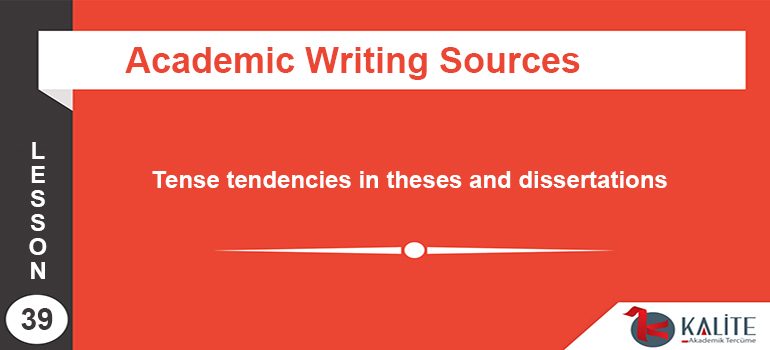
Tense tendencies in theses and dissertations
Different sections of academic papers (theses,dissertations and essays) tend to use different tenses. The following is a breakdown of these tendencies by section. Please note that while it is useful to keep these tendencies in mind, there may be exceptions. The breakdown below should help guide your writing, but keep in mind that you may have to shift tenses in any given section, depending on your topic matter.
Abstract or Summary
| Present simple: for facts and general truisms; to say what the paper does |
| This thesis examines the ways that ecological poetry relates to political activism. |
| Our research suggests better economic policies. |
| Present perfect: for past events or research still relevant to the present |
| Thinkers have examined how ecological poetry relates to political activism. |
| Other economists have suggested different economic policies. |
Introduction
| Present simple: to say what the paper does and why it is important |
| This research is relevant to how we understand the role of poetry. |
| Effective economic policies help societies to prosper. |
| Past simple: to provide historical background |
| In his time, Thoreau concerned himself with living in harmony with nature. |
| Ronald Reagan’s policies changed America’s political landscape. |
Theoretical Framework
| Present simple: to describe theories and provide definitions |
| In lyric poetry, the speaker presents his perspective on a given situation. |
| “Reaganomics” refers to the economic policies of Reagan administration. |
Literature Review
| Present perfect: for past research still relevant to the paper’s current research (see the “Abstract or Summary” section above) |
Methods and Results
| Past simple: for events that began and ended in the past, such as an experiment |
| We conducted semi-structured interviews with the participants. |
| We found that participants had much to say about their workplaces. |
| A multivariate linear regression was used. |
| Present simple: to describe a tool’s function (which does not change over time) |
| Multivariate linear regressions are revelant to use for sets of correlated random variables. |
Conclusions or Discussion
| Present simple: for interpretations of data |
| The results indicate a steady increase in net gain for x and y companies. |
| We cannot conclude that this growth will continue on the basis of this study. |
Limitations
| Past simple: for details about how the study happened |
| The sample size was adequate for a qualitative analysis, but it was not big enough to provide good grounds for predictions. |
Recommendations and Implications
| Modal auxiliary to indicate lack of a certain outcome or simple future with hedging word: for thoughts on what future studies might focus on, and for careful predictions |
| Modal auxiliary: Responses to the survey suggest that many more people in this profession may beunsatisfied with their vacation time. |
| Modal auxiliary: Future research should conduct more sustained investigations of this phenomenon. |
| Simple future with hedging word: The results of the study indicate that the glaciers will likely continue to melt. |


